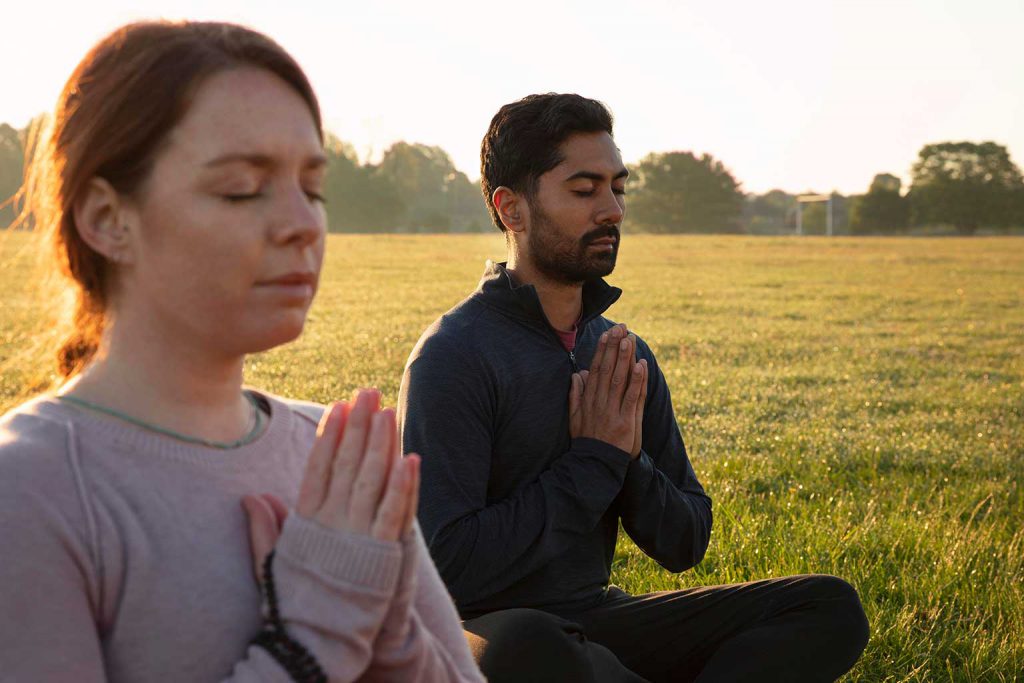We all deal with stress on a daily basis, whether we’re old or young, large or small, lofty thinkers or practical doers.
Even the most practiced meditator and the yogi who radiates peace experience this inevitable aspect of the human experience.
It’s inescapable, and it brings with it a host of uncomfortable and distracting symptoms. Stress isn’t just a feeling or a mental state; if you don’t address it, it seeps into every aspect of your life.
Therefore, in this blog post, we are going to share with you one of the best ways to deal with stress which is Mindfulness Based Stress Reduction (or MBSR). We are going to discuss what it is, where it originates from, its uses, its benefits and most popular MBSR exercises and techniques.
What is Mindfulness-Based Stress Reduction (MBSR)?
In accordance with a book titled “Full catastrophe living: Using the wisdom of your body and mind to face stress, pain, and illness”, mindfulness-based stress reduction is a group program that was developed by Jon Kabat-Zinn in the 1970s to treat patients struggling with life’s difficulties and physical and/or mental illness.
Although it was initially created to aid hospital patients, it has since been used effectively by a wide range of people from all walks of life.
In fact, according to the Center for Mindfulness at the University of Massachusetts, more than 24,000 people have taken advantage of the MBSR program the center debuted in 1979.
MBSR is a flexible and customizable approach to stress reduction. It’s composed of two main components: mindfulness meditation and yoga.
Instead of following a script or acting out meticulously described steps, mindfulness is practiced in the manner that best suits the individual.

While MBSR is often different for every person in practice, it is based on the same set of principles. The following descriptions are pulled straight from the Center for Mindfulness website:
1. Making the experience a challenge rather than a chore and thus turning the observing of one’s life mindfully into an adventure in living rather than one more thing one “has” to do for oneself to be healthy;
2. An emphasis on the importance of individual effort and motivation and regular disciplined practice of the meditation in its various forms, whether one “feels” like practicing on a particular day or not;
3. The immediate lifestyle change that is required to undertake formal mindfulness practice, since it requires a significant time commitment (in the clinic 45 minutes a day, six days a week minimally);
When added to existing medical and/or psychological treatment, MBSR has shown to effectively enhance the results of treatment related to:
Anxiety and panic attacks;
Asthma;
Cancer;
Chronic illness;
Depression;
Eating disorders;
Fatigue;
Fibromyalgia;
Gastrointestinal distress;
Grief;
Headaches;
Heart disease;
High blood pressure;
Pain;
Post-traumatic stress disorder;
Skin disorders;
Sleep problems;
Work, family, and financial stress
With such an impressive list of benefits, it’s hard to argue against giving MBSR a shot, especially since the program does not require an unreasonable amount of time, energy, or resources.
Benefits
Here’s a look at Mindfulness-Based Stress Reduction’s potential health benefits, as tested in scientific studies:
Pain Relief
Mindfulness-Based Stress Reduction may help relieve pain and improve psychological well-being in people dealing with chronic pain conditions, according to a study published in 2010. Researchers found that study members with arthritis showed the greatest improvement in health-related quality of life after undergoing Mindfulness-Based Stress Reduction, while participants with chronic headache/migraine had the smallest improvement.
Stress Management
For a report published in 2009, scientists sized up ten studies on Mindfulness-Based Stress Reduction and found that the program is able to reduce stress levels in healthy people. MBSR also appeared to reduce anxiety and increase empathy.
Better Sleep
Some studies suggest that MBSR may help reduce certain factors (such as worrying) that contribute to sleep problems, according to a report published in 2007. However, in their analysis of seven studies on Mindfulness-Based Stress Reduction and sleep disturbance, the report’s authors found insufficient evidence of MBSR’s ability to significantly improve sleep quality and duration.
Depression Relapse Prevention
Research also suggests that mindfulness approaches may help prevent the reoccurrence of depressive symptoms. Because this mindfulness-based approach focuses on altering negative thought patterns, it can help prevent people from developing negative thoughts and beliefs about themselves. One study found that mindfulness-based cognitive therapy was as effective as antidepressants for preventing depression relapse.
Bias Reduction
Another benefit of mindfulness-based approaches is that they can often help people overcome previously existing association such as biased beliefs. One study found that mindfulness techniques had a positive impact on reducing age and racial biases as measured by implicit association tests.
Cognitive Improvements
Research also suggests that mindfulness-based approaches may also have cognitive benefits. One study found that four sessions of meditation training led to improvements in verbal fluency, mood, visual coding, and working memory. There were also improvements in visual-spatial processing and executive functioning.

Most Popular MBSR Exercises and Techniques
According to the website www.themindfulword.org, there is an excellent outline of some of the most popular Mindfulness-Based Stress Reduction Exercises.
Mindfulness Techniques
As expected, mindfulness is heavily featured in MBSR techniques. While it’s easy to think of mindfulness as a certain state of mind, there are actually several different ways to practice or engage in mindfulness, with varying areas of emphasis.
1. Focus Mindfulness
Popular MBSR Exercises and Techniques focus mindfulnessPracticing mindfulness with an emphasis on focus involves looking inward to observe what is happening in your mind.
It can be described as “eyes on the road” in that there is a singular focus on one experience.
To keep your focus, it can be helpful to use a particular stimulus (like breath) to keep yourself grounded in the moment.
2. Awareness Mindfulness
Unlike focusing, practicing awareness emphasizes the external instead of the internal. Awareness focuses on the mind but from an outside perspective. When trying mindfulness from an awareness angle, try to view your mental activity as if it belonged to someone else.
In general, awareness mindfulness can be described as looking at your thoughts and feelings from outside of your usual self-centered experience and observing your mind as a stream of consciousness without attaching judgment.
For an example of a simple awareness exercise, use the following guide:
“Start by taking your mind inwards for a moment by focusing on the breath. Take a few gentle deep breaths, from the belly. In and out. Relax. Let go. Continue to breathe for as long as you wish.
Now take your mind outwards. See your thoughts, feelings, moods, and sensations as objects floating down a stream, coming into view and vanishing from sight. Simply watch without judgment or analysis. Just watch them pass.
Now pluck an object from the stream and focus on it. Let the other sensations and thoughts go by in the background. Note any new thoughts or feelings that arise from observing this object. Sit with these thoughts and feelings for a moment.
Whenever you’re ready to leave this object behind, simply deposit it on a leaf and let it float downstream”
3. Shifting from Focus to Awareness
Popular MBSR Exercises and Techniques shifting focus to awarenessFor switching from focus mindfulness to awareness mindfulness, try these tips:
Watch the stream of consciousness, dispassionately
Pluck something from the stream and deliberately focus on it (e.g. a dream image, a memory, a painful feeling).

Mindfulness Exercises
The Mindful Word outlines several popular mindfulness exercises, including:
1. The Breath
The exercise described above is one such exercise that facilitates mindfulness by focusing on the breath.
2. Body Scan
Lie with your back on the floor or a bed and close your eyes.
Move your awareness through your body, focusing on one area at a time.
Stop whenever you find an area that is unusually tight or sore and focus your breath on this area until it relaxes.
You can use a calm and healing visualization at this point as well (e.g., a ball of white light melting into the sore spot).
3. Object Meditation
Hold an object that is special or interesting to you. Focus all of your senses on it and note the information your senses feed back to you, including its shape, size, color, texture, smell, taste, or sounds it makes when manipulated.
4. Mindful Eating
Like the previous exercise, this exercise can be completed with all your senses while you focus on eating a particular food, like dark chocolate or a raisin.
Eat slowly, utilizing all five senses: smell, taste, touch, sight, and even sound.
5. Walking Meditation
Take a leisurely walk at a gentle but familiar pace. Observe how you walk and pay attention to the sensations in your body as you walk.
Notice how your shoulders feel (Tight? Loose? Strong?), the sensations in your feet as they meet the ground, the swing of your hips with each stride. Match your breathing to your footsteps.
Takeaway
On the whole, we all experience stress in our daily lives, and sometimes it feels overwhelming. While there are many ways to address this abundance of stress, mindfulness is one that carries extra benefits.
Mindfulness meditation not only addresses current stress, but it can also help you defend against future stress, creating a deep and lasting sense of peace. It can even improve physical measures like blood pressure and heart rate.


